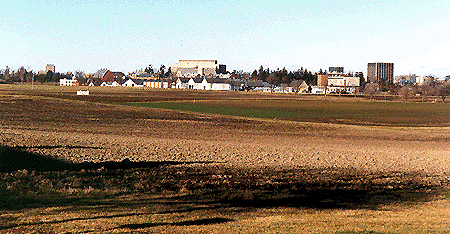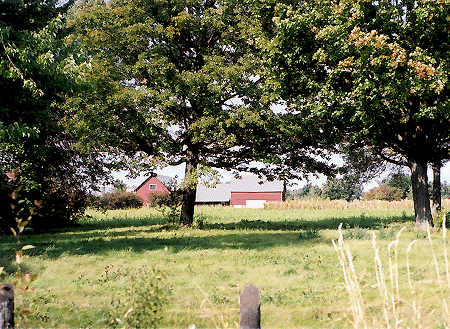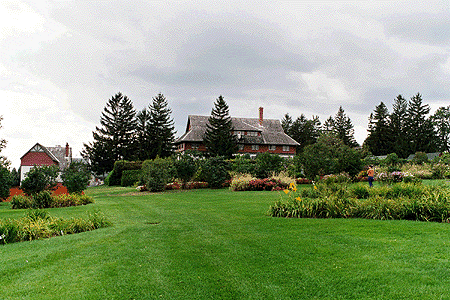II.2 - Recent History
The recent history of the Farm begins in 1986, at the time of the site's 100th anniversary. This event, marked by a Historic Sites and Monuments Board plaque commemorating its role as the research headquarters of a network of experimental stations, created new interest and new expectations. New communities of interest emerged, notably the Friends of the Farm, and a historic self-consciousness became apparent. There was also reconsideration by AAFC of its role on the Farm, and a restructuring of both research programming and headquarters programming on the Farm.

The increased awareness of the Farm's history is reflected in the series of bird's-eye views of the core area prepared by David Bouse of Parks Canada for AAFC in the 1980s. These views documented the patterns of evolution and continuity in the Farm landscape, and served as a basis for Centennial posters and publicity. In the year of the Centennial, the book One Hundred Harvests: Research Branch Agriculture Canada 1886-1986 was published by AAFC. In 1996, Ottawa's Farm, written by Helen Smith, explored the relationship between the CEF and the City.
Central Experimental Farm's Designation as a National Historic Site
With the designation of the Farm as a National Historic Site in 1998, the historical and cultural significance of the site was confirmed and reinforced. The Board pointed out five key features of the site in its reasons for designation:
- Its distinctiveness as a cultural landscape
- The fact that the more than 400-hectare farm in the heart of the Nation's Capital reflects the 19th century philosophy of agriculture and carefully integrates an administrative core and a range of other buildings with Arboretum, Ornamental Gardens, display beds and experimental fields in a picturesque composition
- The fact that since its establishment in 1886, the Central Experimental Farm has made significant scientific contributions to agriculture in Canada by uniting scientific experimentation with practical verification, as exemplified by the development of the hardy strains of wheat that were so influential in expanding Western Canadian agriculture
- The fact that it is a rare example of a farm within a city
- The fact that it has become a symbol of the central role agriculture has played in shaping the country.

Commemorative Integrity Statement
As a follow-up to the designation, a Commemorative Integrity Statement for the Central Experimental Farm was prepared by a committee whose members were drawn from AAFC, Parks Canada, the NCC, the Heritage Conservation Program of PWGSC, NMST, RMOC, CEFAC, Friends of the CEF and Heritage Ottawa. This Statement indicated the key heritage components of the Farm and provided criteria for assessing their ongoing integrity. The statement identifies the site's Level 1 and Level 2 cultural resources, describes their value and establishes objectives for their preservation. The CIS provides a foundation for management and planning initiatives by presenting indicators that focus on historic values and cultural resources of national significance.

Canada Agriculture Museum
A national museum presence was first established at the Farm in 1983 when the Dairy Barn was converted into a museum by the National Museum of Science and Technology (now the Canada Science and Technology Museum Corporation). The original museum consisted of two exhibits in the Main Barn and a meeting room used for public lectures. Its mandate was to collect agricultural implements. In 1996, the Museum entered into an agreement with the AAFC, leasing six buildings (five barns and a former residence) and taking over the showcase herd. One of the barns and the residence were subsequently destroyed in an August 1996 fire. A new barn was later built, and the present lease includes six barns, one administrative building, fenced areas in the vicinity of the barns, grazing lands and a parking lot. In 1983, the Canada Agriculture Museum (as part of the National Museum of Science and Technology) was established on the Farm, in the Main Dairy Barn. The building was partially transformed to provide a controlled central core, and the Museum began to provide active presentation and interpretation of Canadian agricultural history. The Museum's function expanded with the transfer of showcase herds from AAFC to the Museum in 1995. Today it is best known for its special events, family programming and live animal displays.

Private Initiatives
Various non-profit groups have used the Farm for research, education, and recreational purposes. Arrangements with AAFC have often been informal in terms of lease agreements or other land use approvals. The Fletcher Wildlife Garden is one such enterprise. It is a long-term project of the Ottawa Field-Naturalists' Club with support from the Friends of the Farm and the Ottawa Chapter of Landscape Ontario. The goal of the project is to encourage restoration of natural habitats in urban and rural settings and to provide information on natural resource history and conservation. It occupies land east of Prince of Wales and south of the Arboretum.

In recent years there have been more formal private-sector proposals for land lease or transfer, partly in response to questions about AAFC's long-term interests. Farmland west of Merivale has been sold for private commercial and residential development. The Ottawa Botanical Garden Society was established in 1999 to create a proposal for a large botanical garden in the area of the Arboretum, and all the lands east of Prince of Wales Drive. Ottawa's Botanic Garden: A Vision was forwarded to AAFC in June 2000, followed by A Heritage Management Strategy in May 2001. The proposal for a Botanic Garden has focused public interest and debate on long-term visions for the Farm. The shape of the proposal has continued to evolve in response to these discussions, and to date there have been no commitments by AAFC on either this proposal in particular or the future of these eastern lands in general.
Central Experimental Farm Advisory Council
Partly in response to the more complex communities of interest on the Farm, a Central Experimental Farm Advisory Council (CEFAC) was established in 1998 to engage the public more fully in the future management of the CEF site. CEFAC serves as an important means of obtaining public input and providing advice and recommendations to assist AAFC in its stewardship role. The role of the Advisory Council is to: monitor the management and operations/maintenance of the CEF; provide advice on the development and implementation of strategic plans; provide advice and make recommendations on matters referred to them by AAFC management or stakeholders; recommend ways of improving client and stakeholder satisfaction; and provide assistance to AAFC with on-going communications with the public.
Leases, Licences to occupy and Memorandums of Understanding
Since the mid-1990s, leases, licences to occupy and memorandums of understanding have continued to expand. The Ottawa Civic Hospital was given permission to erect and use a helicopter landing pad adjacent to Carling Avenue in 1992. Various buildings have been leased to agricultural agencies for use as office space, including Building 26 to the Canadian 4-H Council in 1998, parts of Building 60 to the Canadian Agricultural Products Act Review Tribunal in 1998 and to the Canadian Agricultural Food Research Council in 2000, Building 54 to the Canadian Centre for Swine Improvement and the Canadian Association of Fairs and Exhibitions in 2002, and Building 55 to the Canadian Dairy Commission in 2002. The Friends of the Farm were given permission to use Building 72 at the Arboretum for office and workshop space. Besides the benefits to the tenants, these arrangements have been an important means of sustaining recognized heritage buildings. There are also issues, however, about how each individual lease arrangement fits into larger patterns of site management.
Adjacent federal custodians have developed their own responses to changing realities on the Farm. Natural Resources Canada, responsible for the Dominion Observatory and its surrounding campus, reduced its presence on site and leased the Observatory to outside agencies, including for a time Heritage Canada. It is now interested in a more public and educational role for its campus. Parks Canada and the National Capital Commission developed their own shoreline parcels on Dow's Lake, and integrated the Central Experimental Farm landscape into Winterlude festivities and other recreational activities. They have their own policy and planning priorities. The Department of National Defence has maintained its presence at the northeast corner of the CEF since the Second World War. HMCS Carleton now functions as a naval reserve unit in the building adjacent to Dow's Lake. The property is the last remaining land from the British Ordnance reserve of the mid-1800s.